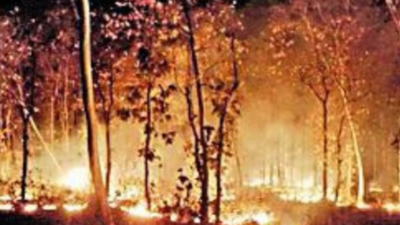- News
- City News
- kolkata News
- West Bengal has 23% more forest fires after no-rain winter
Trending Topics
West Bengal has 23% more forest fires after no-rain winter

Dearth of rain a big factor
KOLKATA: Incidences of forest fires shot up by nearly 23% between February and March in Bengal, according to data collated by the Forest Survey of India (FSI).
The "exceptionally rare" surge for Bengal, said experts, could be attributed to a rainless winter - more than four months of no rain - and corresponded with a 215% rise in forest fires around the country in the same period.
Forest fires are common in western and central India, not in Bengal. But the increase this year - between January and March - was quite steep. Between January 1 and 22, there were no forest fires reported from the state. This went up to 61 in February and 75 in March (all figures collated between the first and the 22nd of each month).
According to the FSI, there were 1,363 major forest fires across the country in February, which rose to 4,299 in March. Andhra Pradesh, Karnataka, Odisha and Chhattisgarh had the most forest fires.
Most damage to forest floor soil, not to trees: Minister
Forest fires have a devastating impact on biodiversity and ecology, apart from contributing to global warming, said HS Debnath, chairman, West Bengal Biodiversity Board. "A forest fire causes the extinction of numerous plants and insects, loss of wildlife habitat and depletion of wildlife and also loss of natural regeneration of and reduction in forest cover," he said.
Forest minister Jyotipriya Mallick said most of the damage from the forest fires in Bengal was "to the soil of the forest floor, not to the trees". He also conceded that Bengal had never seen so many forest fires before 2021. "There have been six forest fires recently in Jhargram, South 24 Parganas, West Midnapore, Purulia and Bankura," he said, adding, "A big factor contributing to forest fires is the dearth of rain." The minister said the government was taking action to contain forest fires and restore soil pH levels. Measures were also being taken to spread awareness in forest-dwelling communities on ways to prevent fires.
Milan Mandal, the Sunderbans divisional forest officer (DFO), said leaves shed in winter makes the forest floor inflammable in rainless hot weather, affecting primarily deciduous trees in Purulia and Bankura.
Warm, dry winds during a rainless winter and spring could spread fires across a forest, said meteorologist G K Das. "Forest residents are advised to exercise precaution while cooking outdoors," he said. Early detection and timely intervention was the key to contain forest fires, said former forest officer Somnath Mukherjee. "There is satellite monitoring of forest fires. Real-time data is crucial to act against forest fires."
Environment minister Manas Bhunia said the risk of rising forest fires would not hamper the government's plan to plant trees along the 270km of Bengal's border, in order to prevent inter-state air pollution. "Local authorities, forest communities and the state government are united in this project," he said.
The "exceptionally rare" surge for Bengal, said experts, could be attributed to a rainless winter - more than four months of no rain - and corresponded with a 215% rise in forest fires around the country in the same period.
Forest fires are common in western and central India, not in Bengal. But the increase this year - between January and March - was quite steep. Between January 1 and 22, there were no forest fires reported from the state. This went up to 61 in February and 75 in March (all figures collated between the first and the 22nd of each month).
According to the FSI, there were 1,363 major forest fires across the country in February, which rose to 4,299 in March. Andhra Pradesh, Karnataka, Odisha and Chhattisgarh had the most forest fires.
Most damage to forest floor soil, not to trees: Minister
Forest fires have a devastating impact on biodiversity and ecology, apart from contributing to global warming, said HS Debnath, chairman, West Bengal Biodiversity Board. "A forest fire causes the extinction of numerous plants and insects, loss of wildlife habitat and depletion of wildlife and also loss of natural regeneration of and reduction in forest cover," he said.
Forest minister Jyotipriya Mallick said most of the damage from the forest fires in Bengal was "to the soil of the forest floor, not to the trees". He also conceded that Bengal had never seen so many forest fires before 2021. "There have been six forest fires recently in Jhargram, South 24 Parganas, West Midnapore, Purulia and Bankura," he said, adding, "A big factor contributing to forest fires is the dearth of rain." The minister said the government was taking action to contain forest fires and restore soil pH levels. Measures were also being taken to spread awareness in forest-dwelling communities on ways to prevent fires.
Milan Mandal, the Sunderbans divisional forest officer (DFO), said leaves shed in winter makes the forest floor inflammable in rainless hot weather, affecting primarily deciduous trees in Purulia and Bankura.
Warm, dry winds during a rainless winter and spring could spread fires across a forest, said meteorologist G K Das. "Forest residents are advised to exercise precaution while cooking outdoors," he said. Early detection and timely intervention was the key to contain forest fires, said former forest officer Somnath Mukherjee. "There is satellite monitoring of forest fires. Real-time data is crucial to act against forest fires."
Environment minister Manas Bhunia said the risk of rising forest fires would not hamper the government's plan to plant trees along the 270km of Bengal's border, in order to prevent inter-state air pollution. "Local authorities, forest communities and the state government are united in this project," he said.
Start a Conversation
FOLLOW US ON SOCIAL MEDIA
FacebookTwitterInstagramKOO APPYOUTUBE









